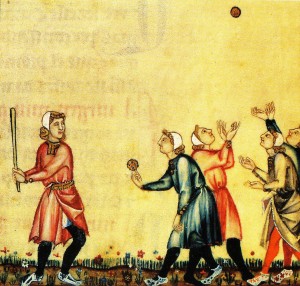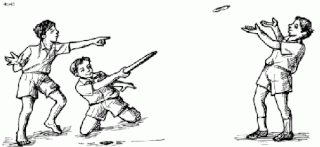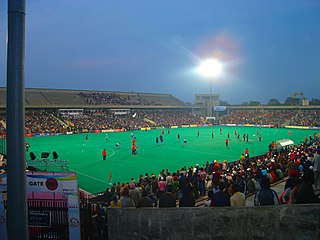
The wicket-keeper in the sport of cricket is the player on the fielding side who stands behind the wicket or stumps being watchful of the batsman and ready to take a catch, stump the batsman out and run out a batsman when occasion arises. The wicket-keeper is the only member of the fielding side permitted to wear gloves and external leg guards. The role of the keeper is governed by Law 27 and of the Laws of Cricket.

This is a general glossary of the terminology used in the sport of cricket. Where words in a sentence are also defined elsewhere in this article, they appear in italics. Certain aspects of cricket terminology are explained in more detail in cricket statistics and the naming of fielding positions is explained at fielding (cricket).

French cricket is a form of cricket that creates a game similar to catch. The game can be played socially at picnics and parties or on parks and beaches. It is a form of cricket that can include children of varied ages.
Short form cricket is a collective term for several modified forms of the sport of cricket, with playing times significantly shorter than more traditional forms of the game.

Tip-cat is a pastime which consists of tapping a short billet of wood, usually no more than 3 to 6 inches, with a larger stick similar to a baseball bat or broom handle. The shorter piece is tapered or sharpened on both ends so that it can be "tipped up" into the air when struck by the larger, at which point the player attempts to swing or hit it a distance with the larger stick while it is still in the air.

Bat-and-ball games are field games played by two opposing teams. Action starts when the defending team throws a ball at a dedicated player of the attacking team, who tries to hit it with a bat and run between various safe areas in the field to score runs (points). The defending team can use the ball in various ways against the attacking team's players to force them off the field when they are not in safe zones, and thus prevent them from further scoring. The best known modern bat-and-ball games are cricket and baseball, with common roots in the 18th-century games played in England.
Qila Raipur Sports Festival, popularly known as the Rural Olympics, is held annually in Qila Raipur, in Punjab, India. Competitions are held for major Punjabi rural sports, include cart-race, athletic events and rope pulling.
Old cat games were bat-and-ball, safe haven games played in North America. The games were numbered according to the number of bases. The number of bases varied according to the number of players. Only one old cat continues to be commonly played in the 21st century.

Dandi biyo is a game played in Nepal which was considered the de facto national game until 23 May 2017, when volleyball was declared as the national sport. Dandi biyo is played with a stick (dandi) about 2 feet (61 cm) long and a wooden pin (biyo) about 6 inches (15 cm) long. The pin is a small wooden stick with pointed ends. The game is similar to the Indian game gilli danda. The government has not implemented any policies for the preservation of dandi biyo, and with decreasing players the game is expected to be extinct soon.

Seven stones is a traditional game from the Indian subcontinent involving a ball and a pile of flat stones, generally played between two teams in a large outdoor area.

Kuttiyum kolum is a traditional game played in Kerala, India. It is similar to an ancient game found all over the Indian Subcontinent with different names, such as Gilli-danda in North India. A similar game by the name of Lippa has been played in Italy. Kuttiyum kolum possibly originated over 2500 years ago.

Cricket is a bat-and-ball game that is played between two teams of eleven players on a field at the centre of which is a 22-yard (20-metre) pitch with a wicket at each end, each comprising two bails balanced on three stumps. Two players from the batting team stand in front of either wicket, with one player from the fielding team bowling the ball towards the striker's wicket from the opposite end of the pitch. The striker's goal is to hit the bowled ball and then switch places with the nonstriker, with the batting team scoring one run for each exchange. Runs are also scored when the ball reaches or crosses the boundary of the field or when the ball is bowled illegally.
Many sports are played by the people of Tamil Nadu including both traditional sports and sports from other countries.

Punjabis play a wide variety of sports and games, ranging from modern games such as hockey and cricket, to the more traditional games such as Kabaddi, Kushtian (wrestling) and Khuddo khoondi. There are over 100 traditional games and sports of Punjab.

Bengali traditional games are traditional games that are played in rural parts of the historical region of Bengal. These games are typically played outside with limited resources. Many games have similarities to other traditional South Asian games.

India has several traditional games and sports, some of which have been played for thousands of years. Their popularity has greatly declined in the modern era, with Western sports having overtaken them during the British Raj, and the Indian government now making some efforts to revive them. Many of these games do not require much equipment or playing space. Some of them are only played in certain regions of India, or may be known by different names and played under different rules and regulations in different regions of the country. Many Indian games are also similar to other traditional South Asian games.

Pakistan has many traditional games played in the rural and urban areas of the country.

South Asia has many traditional games and sports. Two of them, kabaddi and kho-kho, are played at the South Asian Games, with kabaddi also featuring at the Asian Games. Many of these games are played across the entire subcontinent under different names and with some rule variations, while some of these games may be played only in certain countries or regions.
Nepal has many traditional games that are similar to other traditional South Asian games. Many of these games were played during local cultural festivals, but are now disappearing because of technological influence and globalisation.

















